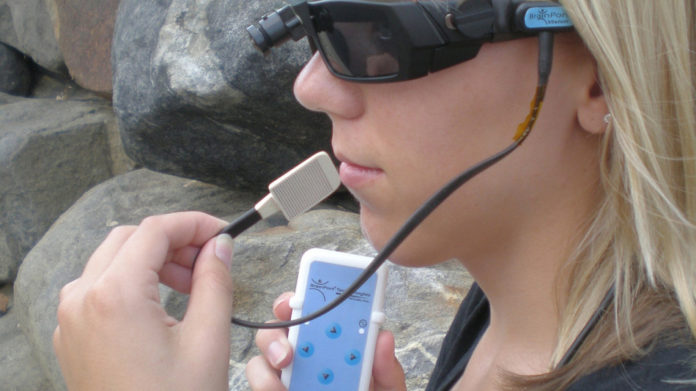Blind Americans can now ‘see’ with a device that uses their tongues

A new device that helps the blind “see” by using their tongues has been approved by the U.S. Food and Drug Administration.
The BrainPort V100, cleared for 250,000 profoundly blind Americans without sensitivity to light, will cost about $10,000, said Robert Beckman, chief executive officer of closely held Wicab Inc. The three-part device captures images with a camera mounted on sunglasses, routes them through a hand-held controller and sends them to a 1-inch square device containing 400 electrical stimulation points that rests on the user’s tongue.
“People are able to learn to interpret these patterns of bubbles or stimulation on their tongue to know what object is in front of them,” Beckman said. “We don’t want to create false hopes,” he said. “They need to learn the technology and practice with it. It’s more akin to learning a new language than it is to ordinary perception.”
People using the BrainPort for the first time can often walk around an oval track, staying within the white lines without assistance, Beckman said. With additional training, they can navigate hallways, read short words such as EXIT, tell the difference between a ball and a banana, and eventually play darts, he said. The BrainPort was approved for use in Europe in 2013, according to the company’s website.
“Medical device innovations like this have the potential to help millions of people,” said William Maisel, deputy director for science at the U.S. Food and Drug Administration. “It is important we continue advancing device technology to help blind Americans live better, more independent lives.”
Brain stimulation
Studies show that people who are blind perceive the electrical stimulation in their visual cortex, the part of the brain responsible for sight. People using the BrainPort who aren’t visually impaired process it as tactile information, Beckman said.
Google Inc. and the U.S. Department of Defense helped fund the device’s development. Wicab, based in Middleton, Wisconsin, licensed a patent on the device from the Wisconsin Alumni Research Foundation, a nonprofit patent and licensing organization for the University of Wisconsin at Madison.
The company hopes to gain insurance reimbursement for the device, though it acknowledges that adoption of the technology may be slow going, especially at first.
“The reality is that most people who are profoundly blind are also quite poor,” Beckman said. “It will take off slowly just because of blind people being so impoverished.”
- Investors Boost Gold Holdings in Longest Run in 7 Weeks
- China Bears Rush to Short U.S. ETF at Record Pace as Rally Fades
- Options Trade: How to Play Micron Ahead of Earnings
- Turbulent Week for European Stocks
This article originally published at Bloomberg Business here

